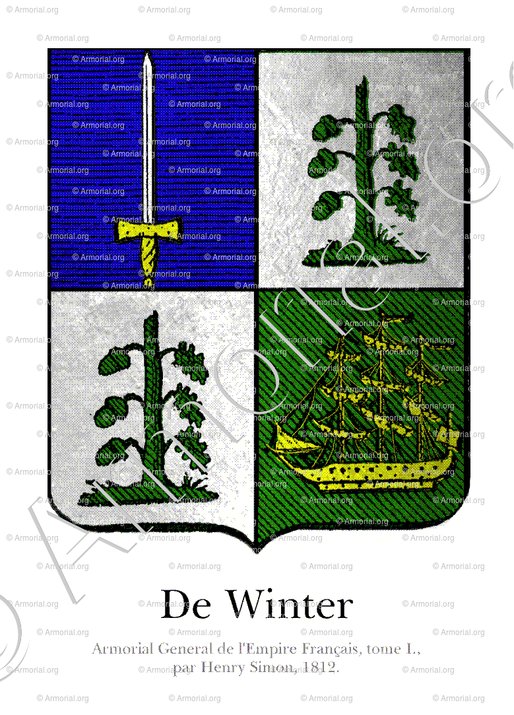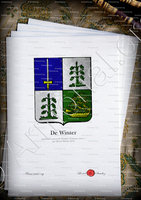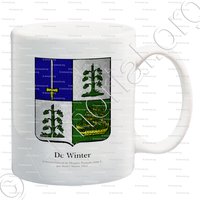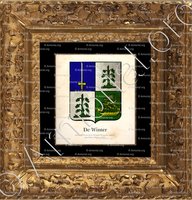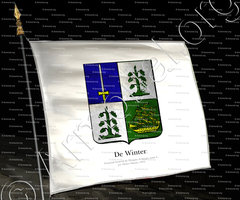DESCRIPTION
De WINTER
Comte de l'Empire
France
Armoiries :
" Écartelé : au 1°, des comtes militaires ; aux 2° et 3°, d’argent au tronc de chêne au naturel, soutenu de sinople, chargé à dextre de trois glands et à sénestre de trois feuilles, le tout du même; au 4°, de sinople au Vaisseau, les voiles ployées, d’or. "
Notes historiques et biographiques :
- Jean—Guillaume de WINTER, comte de l’empire par lettres patentes du 9 mai 1811; créé comtes de Huessen par lettres du roi de Hollande du 4 mai 1810, donataire (r. 30000) sur les départements de la Méditerranée et de l’Ombrone, par décret impérial du 24 février 1811 ; vice-amiral, inspecteur général des Côtes-du-Nord, Officier de la Légion d'honneur ; né à Campen (Pays-Bas), 23 mars 1761, décédé le 2 juin 1812.
(Armorial du premier empire, par Vicomte Révérend, 1897.)
- Jean-Guillaume de WINTER, de son nom de naissance Jan Willem de Winter, né le 23 mars 1761 à Kampen, mort le 2 juin 1812 à Paris, est un amiral puis général néerlandais de la Révolution et de l’Empire.
De Winter se lie au parti patriote qui s'oppose violemment à la politique du Stathouder Guillaume V d'Orange-Nassau, mais l'aide prussienne permet au celui-ci de se défaire des patriotes en 1787, entraînant leur exode massif. Approuvant la Révolution française, Jean-Guillaume de Winter se réfugie alors en France.
En 1795, il rentre dans les provinces néerlandaises dans l'armée de Pichegru avec le grade de général de brigade ; il s'illustre lors de la capture de la flotte hollandaise au Helder, lorsque Pichegru l'envoie à pied avec des troupes sur la mer gelée prendre possession de 15 vaisseaux de guerre hollandais immobilisés par la glace — l'hiver 1794-1795 est notablement rude. En mai 1797, il perd la bataille de Camperdown face à la flotte britannique.
Il devient en 1798 ministre plénipotentiaire de la République batave à Paris. Louis Bonaparte, devenu roi de Hollande, le fait maréchal, comte (en Hollande) et commandant en chef de ses armées de terre et de mer.
Napoléon le nomme successivement officier de la Légion d'honneur, inspecteur général des côtes de la mer du Nord, commandant en chef des forces navales réunies au Texel et enfin comte de l'Empire.
Il tombe malade en 1812 et doit transmettre le commandement en chef à l'amiral Ver-Huell.
Jean-Guillaume de Winter, comte de Huessen, meurt le 2 juin 1812 à Paris. Il est inhumé au Panthéon de Paris, mais son cœur est conservé dans une urne, dans l'église Saint-Nicolas (Bovenkerk), située dans sa ville natale de Kampen. Bien qu'il y fût honoré, son attitude lui a valu d'être considéré comme un traître aux Pays-Bas.
(wikipedia).
Sources :
- Armorial General de l'Empire Français, tome I., par Henry Simon, 1812.
____________***********_____________
De WINTER
Graaf van het rijk
Frankrijk
Wapenschild:
" Quarterly: 1°, militaire tellingen; 2° en 3°, zilver, met een eiken stam, natuurlijk, ondersteund in vert (groen), geladen op de rechtse, met drie eikels, en op de sinistere, met drie bladeren, de allemaal hetzelfde; op 4°, Vert (groen) naar de Vaisseau, de zeilen gebogen, goud. "
Historische en biografische aantekeningen:
- Jean-Guillaume de WINTER, graaf van het rijk bij patentbrieven van 9 mei 1811; creëerde graven van Huessen door brieven van de koning van Holland op 4 mei 1810, donateur (r. 30.000) over de departementen van de Middellandse Zee en Ombrone, bij keizerlijk decreet van 24 februari 1811; Vice-admiraal, inspecteur-generaal van Côtes-du-Nord, Officier in het Legioen van Eer; geboren te Campen (Nederland), 23 maart 1761, overleden 2 juni 1812.
(Armorial van het eerste rijk, door Burggraaf Reverend, 1897).
- Jean-Guillaume de Winter, bij zijn geboortenaam Jan Willem de Winter, geboren op 23 maart 1761 in Kampen, overleden op 2 juni 1812 in Parijs, was een Nederlandse admiraal en toen generaal van de Revolutie en het Keizerrijk.
De Winter bindt zich aan de patriotpartij die zich met geweld verzet tegen het beleid van stathouder Guillaume V van Oranje-Nassau, maar Pruisische hulp stelt deze in staat om in 1787 van de patriotten af te komen, wat leidt tot hun massale uittocht. Jean-Guillaume de Winter keurde de Franse Revolutie goed en vluchtte vervolgens naar Frankrijk.
In 1795 keerde hij terug naar de Nederlandse provincies in het leger van Pichegru met de rang van brigadegeneraal; hij onderscheidde zich tijdens de verovering van de Nederlandse vloot bij Helder, toen Pichegru hem te voet met troepen op de bevroren zee stuurde om 15 door het ijs geïmmobiliseerde Nederlandse oorlogsschepen in bezit te nemen - de winter van 1794-1795 was bijzonder streng. In mei 1797 verloor hij de Slag bij Camperdown aan de Britse vloot.
In 1798 werd hij in Parijs Gevolmachtigd Minister van de Bataafse Republiek. Lodewijk Bonaparte, die koning van Holland was geworden, benoemde hem tot maarschalk, graaf (in Holland) en opperbevelhebber van zijn land- en zeelegers.
Napoleon benoemde hem achtereenvolgens tot Officier in het Legioen van Eer, Inspecteur-Generaal van de Noordzeekust, Opperbevelhebber van de op Texel verenigde zeestrijdkrachten en ten slotte tot Graaf van het Keizerrijk.
Hij werd in 1812 ziek en moest het bevel overdragen aan admiraal Ver-Huell.
Jean-Guillaume de Winter, graaf van Huessen, stierf op 2 juni 1812 in Parijs. Hij wordt begraven in het Panthéon in Parijs, maar zijn hart wordt bewaard in een urn in de Sint-Niklaaskerk (Bovenkerk), gelegen in zijn geboorteplaats Kampen. Hoewel hij daar werd geëerd, leidde zijn houding ertoe dat hij in Nederland als een verrader werd beschouwd.
(wikipedia).
Bronnen:
- Wapenkundige generaal van het Franse rijk, deel I., door Henry Simon, 1812.
____________***********_____________
De WINTER
Count of the Empire
France
Coat of arms:
" Quarterly: 1°, military counts; 2° and 3°, silver, with an oak trunk, natural, supported in vert (green), charged on the dexter, with three acorns, and on the sinister, with three leaves, the all the same; at 4°, Vert (green) to the Vaisseau, the sails bent, gold. "
Historical and biographical notes:
- Jean-Guillaume de WINTER, count of the empire by letters patent of May 9, 1811; created Counts of Huessen by letters from the King of Holland on May 4, 1810, donee (r. 30,000) over the departments of the Mediterranean and Ombrone, by imperial decree of February 24, 1811; Vice-Admiral, Inspector General of Côtes-du-Nord, Officer of the Legion of Honor; born in Campen (Netherlands), March 23, 1761, died June 2, 1812.
(Armorial of the first empire, by Viscount Reverend, 1897.)
- Jean-Guillaume de WINTER, by his birth name Jan Willem de Winter, born March 23, 1761 in Kampen, died June 2, 1812 in Paris, was a Dutch admiral then general of the Revolution and the Empire.
De Winter binds to the patriot party which violently opposes the policy of Stathouder Guillaume V of Orange-Nassau, but Prussian aid allows the latter to get rid of the patriots in 1787, leading to their mass exodus. Approving the French Revolution, Jean-Guillaume de Winter then took refuge in France.
In 1795, he returned to the Dutch provinces in the army of Pichegru with the rank of brigadier general; he distinguished himself during the capture of the Dutch fleet at Helder, when Pichegru sent him on foot with troops on the frozen sea to take possession of 15 Dutch warships immobilized by the ice - the winter of 1794-1795 was notably harsh. In May 1797, he lost the Battle of Camperdown to the British fleet.
In 1798 he became Minister Plenipotentiary of the Batavian Republic in Paris. Louis Bonaparte, having become king of Holland, made him marshal, count (in Holland) and commander-in-chief of his land and sea armies.
Napoleon successively appointed him Officer of the Legion of Honor, Inspector General of the North Sea coast, Commander-in-Chief of the naval forces united at Texel and finally Count of the Empire.
He fell ill in 1812 and had to hand over command to Admiral Ver-Huell.
Jean-Guillaume de Winter, Count of Huessen, died on June 2, 1812 in Paris. He is buried in the Panthéon in Paris, but his heart is kept in an urn in the church of Saint-Nicolas (Bovenkerk), located in his hometown of Kampen. Although he was honored there, his attitude led to him being considered a traitor in the Netherlands.
(https://fr.wikipedia.org/wiki/Jean-Guillaume_de_Winter)
Sources:
- Armorial General of the French Empire, volume I., by Henry Simon, 1812
SHARE ON SOCIAL NETWORKS
OPINIONS
There are no notes at this time. Be the first to rate!
GIVE A NOTE




